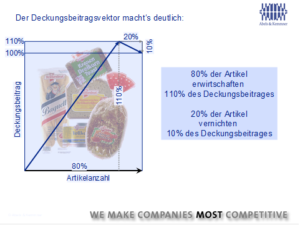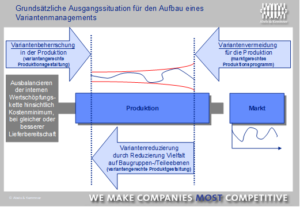Optimization of the product portfolio at Kronenbrot
by Dr. Götz-Andreas Kemmner
The German baked goods industry is characterized by a wide range of products and variants. To ensure that this high degree of customer orientation does not ultimately eat into earnings, the product portfolio must be regularly analyzed and optimized.
What began in 1865 as a small country bakery has developed into one of the most modern industrial bakeries, which bakes baked goods in Würselen/Aachen, Cologne and Witten for the region of North Rhine-Westphalia, Rhineland-Palatinate, Belgium and the Netherlands. Today, Kronenbrot is the leading supplier of bread and baked goods in the North Rhine-Westphalian food trade. Around 3,000 retail partners – food retailers and bulk consumers – are supplied with fresh baked goods every day.
Kronenbrot is known on the market for its ongoing innovation in its range of baked goods. In addition to bread, toast and rolls, cakes, pastries and stollen, the Kronenbrot range also includes European specialties such as Italian ciabatta and ciabatta rolls, Turkish flatbread, French baguettes, baguette rolls, brioche and croissants.
Kronenbrot was one of the first bakeries to stop using preservatives more than a decade ago. This is only possible if the grocery stores are supplied with freshly baked bread straight from the oven in the early hours of the morning and the bread does not have to be transported over long distances.
It is not feasible for Kronenbrot to have a finished goods warehouse to cushion the logistical impact of fluctuating market demand compared to production, as yesterday’s goods can no longer be sold today. Instead, an assortment of around 600 items has to be produced and baked every day in sync with market demand. In some cases, delivery and production batch sizes only correspond to very small quantities, the production of which has little to do with the idea of a “large” bakery, as the following figures show:
As is usual for most companies, it was found that the Würselen plant also generates around 80% of sales with 20% of items (easily predictable AB-XY items), but this group is offset by a group of over 25% of items (non-predictable CZ2 items), which together generate less than 5% of sales. Such a large number of variants with small batch sizes increases the process costs associated with handling small quantities and entails the risk that certain items can no longer be produced economically.
As part of a project to analyze the potential of the Würselen plant, which was commissioned by Kronenbrot KG to Abels & Kemmner, the product portfolio was therefore subjected to a critical review. The aim of this project step was to streamline the current product range from a business and sales perspective.
From a logistical point of view, you should avoid variant diversity wherever possible. If they already exist, it is therefore first necessary to check whether and how they can be reduced. In order to start at the right point here, it is best to analyze the contribution margins of the articles, both in terms of absolute values and unit contribution margins. Depending on the sales opportunities, articles with negative contribution margins should be
- their contribution margins can be improved,
- be deleted,
- expire,
- be replaced by substitute products with higher contribution margins or
- be procured externally,
because with these articles you add money to every item produced.
 Basic starting point for the development of variant management
Basic starting point for the development of variant management
The demand structure of the articles has an important influence on the question of which alternative should be given preference. Items whose demand is difficult to forecast pose particular problems, especially with regard to the lack of storage options for buffering demand. In these cases, it therefore makes more sense to replace the item than to optimize its costs. However, negative contribution margins are not only found among items with poor predictability, which was also confirmed by the analysis at Kronenbrot.
In addition to the replacement of articles with a negative contribution margin and poor predictability, particular attention should be paid to articles that generate strong sales but also generate a – usually low – negative contribution margin per unit. Here, however, the options for action are more limited. Products of this type can only be
- their contribution margins can be improved,
- or replaced by substitute products with higher contribution margins
because external procurement, deletion or phasing out would inevitably lead to major cuts in the company.

Calculate with the right numbers
The contribution margin analysis assumes that the cost accounting system is sufficiently differentiated to calculate the correct contribution margins and uncover the causes of negative contribution margins. However, it is not uncommon for consultants to encounter the problem that contribution margins first have to be calculated correctly. Incidentally, the data for the ABC-XYZ analyses is similar. Here too, a sufficiently differentiated database often has to be created first.
At Kronenbrot, the alternative alternative product does not necessarily require the use of different recipes. Sometimes it is sufficient to standardize packaging or to implement packaging variants in a simpler way or to reduce the number of different sales weights of a baked good. By streamlining marginal variants, a positive contribution margin can be generated for the majority of these products.
 Basic starting point for the development of variant management
Basic starting point for the development of variant management
Where end products or end product variants cannot be dispensed with, attempts must be made to reduce the variety of articles at upstream production levels. If you imagine the end products as leaves, the aim is to form a tree from a shrub: A trunk that emerges from the earth and branches out as late as possible. In technical areas, assemblies are standardized for this purpose. The “platform strategy” familiar from the automotive industry pursues precisely this goal of producing a wide range of variants from just a few assemblies. This strategy is more difficult to pursue in the production of baked goods and, where it is possible, such as with fruit Danish pastries, it has already led to a wide range of variations.
Ultimately, the remaining variant diversity with a negative contribution margin must be further optimized in production. Strategic levers for this at Kronenbrot are, for example, special baking lines for small quantities, which are constantly being optimized.
Outlook
Although baked goods are “our daily bread”, purchasing habits are increasingly changing and, last but not least, new product ideas from Kronenbrot are also leading to changes in purchasing behavior. Optimizing the product portfolio is therefore also a task for baked goods that should be carried out regularly and at least once a year, just as trees are pruned annually so that they grow into the right shape. In order to be able to carry out portfolio optimization systematically in the future, the next step is to automate the necessary data selection, preparation and processing to a greater extent. In line with the Kronenbrot philosophy that a traditional family business also has a special responsibility towards its employees, the optimization of the product portfolio is an important step towards securing jobs in the face of growing competition.

